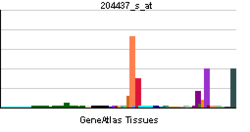Folate receptor 1
Folate receptor alpha is a protein that in humans is encoded by the FOLR1 gene.[1][2]
The protein encoded by this gene is a member of the folate receptor (FOLR) family. Members of this gene family have a high affinity for folic acid and for several reduced folic acid derivatives, and mediate delivery of 5-methyltetrahydrofolate to the interior of cells.
This gene is composed of 7 exons; exons 1 through 4 encode the 5' UTR and exons 4 through 7 encode the open reading frame. Due to the presence of 2 promoters, multiple transcription start sites, and alternative splicing of exons, several transcript variants are derived from this gene. These variants differ in the lengths of 5' and 3' UTR, but they encode an identical amino acid sequence.[2]
Clinical significance
FRA can be overexpressed by a number of epithelial-derived tumors including ovarian, breast, renal, lung, colorectal, and brain. Hence antibodies to it are used in targeted therapies and diagnostic tests, e.g. farletuzumab in phase III trial for ovarian cancer.
See also
References
- ↑ Campbell IG, Jones TA, Foulkes WD, Trowsdale J (Oct 1991). "Folate-binding protein is a marker for ovarian cancer". Cancer Res 51 (19): 5329–38. PMID 1717147.
- ↑ 2.0 2.1 "Entrez Gene: FOLR1 folate receptor 1 (adult)".
Further reading
- Henderson GB (1990). "Folate-binding proteins". Annu. Rev. Nutr. 10: 319–35. doi:10.1146/annurev.nu.10.070190.001535. PMID 2166548.
- Kelemen LE (2006). "The role of folate receptor alpha in cancer development, progression and treatment: cause, consequence or innocent bystander?". Int. J. Cancer 119 (2): 243–50. doi:10.1002/ijc.21712. PMID 16453285.
- Ragoussis J, Senger G, Trowsdale J, Campbell IG (1992). "Genomic organization of the human folate receptor genes on chromosome 11q13". Genomics 14 (2): 423–30. doi:10.1016/S0888-7543(05)80236-8. PMID 1330883.
- Sadasivan E, Cedeno M, Rothenberg SP (1992). "Genomic organization of the gene and a related pseudogene for a human folate binding protein". Biochim. Biophys. Acta 1131 (1): 91–4. doi:10.1016/0167-4781(92)90103-7. PMID 1581364.
- Coney LR; Tomassetti A; Carayannopoulos L et al. (1991). "Cloning of a tumor-associated antigen: MOv18 and MOv19 antibodies recognize a folate-binding protein". Cancer Res. 51 (22): 6125–32. PMID 1840502.
- Lacey SW; Sanders JM; Rothberg KG et al. (1989). "Complementary DNA for the folate binding protein correctly predicts anchoring to the membrane by glycosyl-phosphatidylinositol". J. Clin. Invest. 84 (2): 715–20. doi:10.1172/JCI114220. PMC 548937. PMID 2527252.
- Sadasivan E, Rothenberg SP (1989). "The complete amino acid sequence of a human folate binding protein from KB cells determined from the cDNA". J. Biol. Chem. 264 (10): 5806–11. PMID 2538429.
- Elwood PC (1989). "Molecular cloning and characterization of the human folate-binding protein cDNA from placenta and malignant tissue culture (KB) cells". J. Biol. Chem. 264 (25): 14893–901. PMID 2768245.
- Sadasivan E, Rothenberg SP (1989). "Molecular cloning of the complementary DNA for a human folate binding protein". Proc. Soc. Exp. Biol. Med. 189 (2): 240–4. doi:10.3181/00379727-189-42804. PMID 3194438.
- Luhrs CA; Pitiranggon P; da Costa M et al. (1987). "Purified membrane and soluble folate binding proteins from cultured KB cells have similar amino acid compositions and molecular weights but differ in fatty acid acylation". Proc. Natl. Acad. Sci. U.S.A. 84 (18): 6546–9. doi:10.1073/pnas.84.18.6546. PMC 299115. PMID 3476960.
- Yan W, Ratnam M (1995). "Preferred sites of glycosylphosphatidylinositol modification in folate receptors and constraints in the primary structure of the hydrophobic portion of the signal". Biochemistry 34 (44): 14594–600. doi:10.1021/bi00044a039. PMID 7578066.
- Saikawa Y; Price K; Hance KW et al. (1995). "Structural and functional analysis of the human KB cell folate receptor gene P4 promoter: cooperation of three clustered Sp1-binding sites with initiator region for basal promoter activity". Biochemistry 34 (31): 9951–61. doi:10.1021/bi00031a018. PMID 7632694.
- Prasad PD; Ramamoorthy S; Moe AJ et al. (1994). "Selective expression of the high-affinity isoform of the folate receptor (FR-alpha) in the human placental syncytiotrophoblast and choriocarcinoma cells". Biochim. Biophys. Acta 1223 (1): 71–5. doi:10.1016/0167-4889(94)90074-4. PMID 8061055.
- Maruyama K, Sugano S (1994). "Oligo-capping: a simple method to replace the cap structure of eukaryotic mRNAs with oligoribonucleotides". Gene 138 (1–2): 171–4. doi:10.1016/0378-1119(94)90802-8. PMID 8125298.
- Elwood PC; Nachmanoff K; Saikawa Y et al. (1997). "The divergent 5' termini of the alpha human folate receptor (hFR) mRNAs originate from two tissue-specific promoters and alternative splicing: characterization of the alpha hFR gene structure". Biochemistry 36 (6): 1467–78. doi:10.1021/bi962070h. PMID 9063895.
- Suzuki Y; Yoshitomo-Nakagawa K; Maruyama K et al. (1997). "Construction and characterization of a full length-enriched and a 5'-end-enriched cDNA library". Gene 200 (1–2): 149–56. doi:10.1016/S0378-1119(97)00411-3. PMID 9373149.
- Barber RC; Shaw GM; Lammer EJ et al. (1998). "Lack of association between mutations in the folate receptor-alpha gene and spina bifida". Am. J. Med. Genet. 76 (4): 310–7. doi:10.1002/(SICI)1096-8628(19980401)76:4<310::AID-AJMG6>3.0.CO;2-T. PMID 9545095.
- Tomassetti A; Bottero F; Mazzi M et al. (1999). "Molecular requirements for attachment of the glycosylphosphatidylinositol anchor to the human alpha folate receptor". J. Cell. Biochem. 72 (1): 111–8. doi:10.1002/(SICI)1097-4644(19990101)72:1<111::AID-JCB12>3.0.CO;2-1. PMID 10025672.
